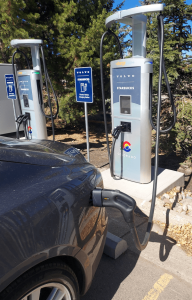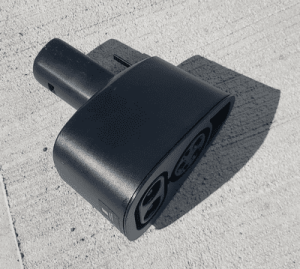
It will be recalled (blog article, September 8, 2023) that recently a set of four charging kiosks popped up in a corner of a Target store parking lot in Silverthorne, Colorado. Today’s news is that the charging kiosks have now been placed into service. I did a brief charging session at one of the kiosks. The charging was much slower than promised. It was extremely difficult to unplug the charging plug from the car. And according to the information on the kiosk display screen, the charging was fairly expensive, though still cheaper than gasoline.
Each of the four kiosks at this charging station says, on its display screen, that it can charge at 200 kW. This means the electrical service transformer, which is rated at 1 megawatt, is right-sized for this group of kiosks.

Each of the kiosks at this charging station has two charging plugs — a CHAdeMO plug (Wikipedia article) and a CCS1 plug (Wikipedia article). If you are driving a Tesla vehicle, this means that you need to use a CCS1-to-NACS adapter such as the one shown at right. These adapters are big and clunky, but if you need to charge up your Tesla vehicle and if you are at a charging station with a CCS1 plug, this kind of adapter is exactly what is needed.
For this charging test, I started by backing into the parking spot at the kiosk. I realized, however, that it it might not have been necessary to back in. Each of these kiosks has a very long cable on a retractable overhead line, so that a person will actually have a fair chance of getting the cable to reach to the distant end of the vehicle no matter which way the car is parked.
My next step was to swipe my Chargepoint card at the kiosk. This unlocked the kiosk. I was then able to unplug the charging plug from its holster. I then jammed the adapter onto the charging plug. This is not at all easy to do, and it took all of the strength in both arms, with two tries, to get the adapter all the way into place on the charging plug. (This is the easy direction. Imagine that if this direction requires a lot of struggle, how difficult it might be to pull the adapter off from the charging plug later.)
I tapped the charging port cover on my car, and it swung open. I plugged the adapter into the charging port. There were some clicking sounds and then the cheery green pulsing light at the charging port reassured me that charging had begun.

I am pretty sure that absolutely every time any driver ever plugs in their car to be charged at a new charging station that one has not used before, the immediate next thing that happens is the driver looks to see just exactly how fast the charging is going on. I am really pretty sure about this. And then the next thing that nearly always happens is, the driver pulls out his or her phone to snap a photo of the car dashboard to memorialize how fast or slow the charging turned out to be. Here is my snapshot.
My Tesla car, when plugged in at a Tesla supercharger, will sometimes charge as fast as 350 kW. When I was at this charging station, the other three kiosks were empty. Given that the advertised charging speed was 200 kW, I figured I would get 200 kW. When I plugged in at this charging station, as you can see in the snapshot, the car charged at only 46 kW. This is only about one-fourth of the advertised speed. (Of course this is still about four times faster than home charging at 11½ kW.)
My reason for plugging in was not really to charge up the car — it was just to sort of test out the charging experience. So after a minute or so I decided to try to unplug the charging plug from the car. There is a push button on the charging plug. I figured that if I were to push the button, this would unlock the plug from the charging port and I would be able to unplug it. Nope. What I was watching for was for the charging port on the car to turn white, which on a Tesla car means “now you can unplug the charging plug.” But no, pushing the button on the charging plug had no effect. The pulsing green LED let me know that charging was still going on.
I hopped into the car, and went to the dashboard of the car, and tapped around and found a charging screen and a place to tap for “unlock charging port.” I tapped on that place on the screen, but there was no beep or visual cue or other kind of response that gave me any sense that I had accomplished anything by tapping. I hopped out of the car and went to the charging port. It was still pulsing green, which told me that it would still be impossible to unplug.
I then mentally reviewed something that I had read recently in the car user manual, namely that there is some hidden secret place in the trunk of the car where, if you know exactly where to probe, you can somehow penetrate the upholstered sidewall of the trunk and somehow get your fingers onto a release latch. Pulling the latch will (I guess) somehow unlock the charging plug.
I figured maybe somewhere at this charging station, there would be some prominently displayed telephone number to call for tech support. Maybe a tech support person could unlock the charging plug by remote control. Nope. I did not see any posted telephone number.
But I figured there was one more place to look — the kiosk display screen. Sure enough, on the (barely visible) touch screen was a (barely visible) red button labeled “release charging plug”. I tapped it and somehow this made the screen change. I was just barely able to make out a place on the screen that possibly said something like “charging plug released”.
I then returned to the car and sure enough, the charging port was lit up in white. This meant that the plug is unlocked. So I unplugged the charging adapter. I then had to wrestle the adapter off from the charging plug, which was not at all easy. Then I replaced the charging plug into its holster.
I then tried to see how much money I had just spent. As best I could make out on the hard-to-read kiosk screen, I had just spent 95¢ to purchase 2 kWh.
Those same two kWh, if purchased at home, would have cost only about 26¢.
The driving range that I had just purchased at this kiosk, if I had instead purchased by putting gasoline into an ICE vehicle, might have cost around $1 to $1.50.
An oddity is that as of today, this Chargepoint charging station is not visible in the Chargepoint web site (“find a charger”) and is not visible in the “find a charger” section of the Chargepoint smart phone app.
One Reply to “After a month, newly constructed charging station is turned on”